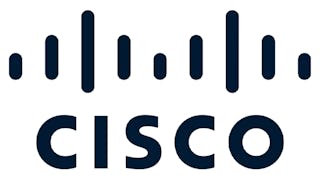In this course, we deal with the general issues regarding packet switching networks. We discuss packet networks from two perspectives. One perspective involves external view of the network, and is concerned with services that the network provides to the transport layer that operates above it at the end systems. The second perspective is concerned with the internal operation of a network, including approaches directing information across the network, addressing and routing procedures, as well as congestion control inside the network.

Enjoy unlimited growth with a year of Coursera Plus for $199 (regularly $399). Save now.

Packet Switching Networks and Algorithms
This course is part of Computer Communications Specialization

Instructor: Xiaobo Zhou
44,142 already enrolled
Included with
(455 reviews)
Skills you'll gain
Details to know

Add to your LinkedIn profile
See how employees at top companies are mastering in-demand skills

Build your subject-matter expertise
- Learn new concepts from industry experts
- Gain a foundational understanding of a subject or tool
- Develop job-relevant skills with hands-on projects
- Earn a shareable career certificate

There are 5 modules in this course
This module introduces LAN bridges and data link layer switching, and then focuses on packet switching at the network layer. It discusses datagram, one basic packet switching approaches.
What's included
4 videos6 readings2 assignments1 discussion prompt
This module examines the other basic packet switching approach - virtual circuit, introduces basic approaches for selecting routes across the network, discusses the Bellman-ford algorithm for distance vector based shortest path routing.
What's included
3 videos4 readings2 assignments1 discussion prompt
This module introduces the link state routing, examines the Dijkstra algorithm for shortest-path routing, and discusses the applications of the distance vector and link state routing in real Internet protocols.
What's included
4 videos4 readings2 assignments1 discussion prompt
This module discusses packet-level traffic management operating in a short time scale, continues with traffic management at the flow level operating in a medium time scale. Common approaches including scheduling, queuing, admission control, and congestion control are discussed.
What's included
4 videos5 readings2 assignments1 discussion prompt
This is a comprehensive peer review assessment
What's included
1 peer review
Earn a career certificate
Add this credential to your LinkedIn profile, resume, or CV. Share it on social media and in your performance review.
Instructor

Offered by
Explore more from Computer Security and Networks
 Status: Free Trial
Status: Free Trial Status: Free Trial
Status: Free TrialCisco Learning and Certifications
 Status: Free Trial
Status: Free Trial Status: Free Trial
Status: Free Trial
Why people choose Coursera for their career




Learner reviews
455 reviews
- 5 stars
81.31%
- 4 stars
13.84%
- 3 stars
3.07%
- 2 stars
0.43%
- 1 star
1.31%
Showing 3 of 455
Reviewed on Jun 19, 2020
very informative content provided without wasteing time
Reviewed on Jun 28, 2020
This course make us to analyze packet switching networks and routing algorithms
Reviewed on May 16, 2020
Very useful course, gained knowledge in Deapth about computer networks

Open new doors with Coursera Plus
Unlimited access to 10,000+ world-class courses, hands-on projects, and job-ready certificate programs - all included in your subscription
Advance your career with an online degree
Earn a degree from world-class universities - 100% online
Join over 3,400 global companies that choose Coursera for Business
Upskill your employees to excel in the digital economy
Frequently asked questions
To access the course materials, assignments and to earn a Certificate, you will need to purchase the Certificate experience when you enroll in a course. You can try a Free Trial instead, or apply for Financial Aid. The course may offer 'Full Course, No Certificate' instead. This option lets you see all course materials, submit required assessments, and get a final grade. This also means that you will not be able to purchase a Certificate experience.
When you enroll in the course, you get access to all of the courses in the Specialization, and you earn a certificate when you complete the work. Your electronic Certificate will be added to your Accomplishments page - from there, you can print your Certificate or add it to your LinkedIn profile.
Yes. In select learning programs, you can apply for financial aid or a scholarship if you can’t afford the enrollment fee. If fin aid or scholarship is available for your learning program selection, you’ll find a link to apply on the description page.
More questions
Financial aid available,
¹ Some assignments in this course are AI-graded. For these assignments, your data will be used in accordance with Coursera's Privacy Notice.

